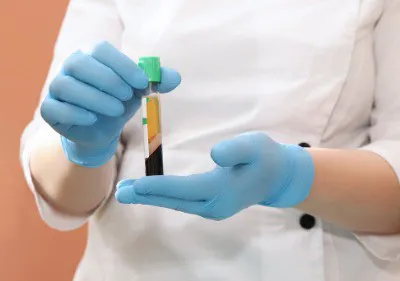Most of us are used to thinking about treatments as something foreign being added in: a filler, a chemical peel, a laser. Effective, yes, but undeniably external. The appeal of PRP lies in the opposite. It starts with you. A small vial of your own blood, spun down into a concentrated serum rich with platelets, becomes the raw material for repair and renewal.
The problem is, this process can sound vague until you break it down. People hear "plasma" and picture something futuristic, almost clinical to the point of being cold. But the truth is less intimidating and far more fascinating. Platelets are not just clot-formers; they’re messengers. Packed with growth factors, they tell your body to build collagen, create fresh cells, and boost circulation right where it is needed most. If your skin is looking dull, if your hair feels thinner than it used to, or if healing takes longer than it should, those are signs your tissues could use that extra nudge.
And here’s where the agitation comes in: the longer we ignore those quiet signs of slowing regeneration, the more they settle in. Lines deepen, elasticity drops, hair sheds. Expensive creams promise to rewind the clock, but surface-level fixes rarely reach the roots of the problem. That gap between what you hope for and what you see in the mirror is exactly what PRP is designed to bridge.
The solution is surprisingly straightforward. PRP harnesses the regenerative potential of your own biology in a targeted, precise way. It is not about instant transformation, but about setting a cascade of renewal in motion. Over the following weeks, new collagen is laid down, circulation improves, follicles strengthen. It is subtle at first, then unmistakable. Natural, progressive, yours.
So how does this process actually work, step by step, from blood draw to visible results?
Our Preferred Partner - Cellenis PRP
Not all PRP systems are created equal — and the quality of preparation makes a big difference to outcomes. That’s why many leading clinics choose Cellenis® PRP, a clinically validated system designed to deliver highly concentrated, pure platelet-rich plasma every time. By using a closed, sterile kit and advanced centrifugation, Cellenis® ensures consistency, safety, and optimal platelet yield — the growth factors your skin, hair, or tissue rely on for regeneration. Whether the goal is brighter skin, fuller hair, or faster recovery, Cellenis® PRP offers practitioners and patients confidence in both the science and the results.
What Is PRP? A Quick Refresher
rious about PRP therapy but not quite sure what it involves? You’re not alone. Platelet-rich plasma (PRP) is often mentioned in the same breath as cutting-edge regenerative treatments, but what actually is it, and why are more people turning to it for skin, hair, and joint health?
Harnessing the Healing Power of Your Blood
PRP therapy uses a concentrated form of your own blood to accelerate healing and regeneration.
Here’s how it works, and why it’s so widely used:
- Platelets do more than just clot blood
While best known for stopping bleeding, platelets are also packed with growth factors - natural signalling proteins that help repair damaged tissue, stimulate cell turnover, and promote collagen production. - PRP is drawn from your own blood
A small blood sample (typically 10–30ml) is spun in a centrifuge to separate the red cells from the plasma and platelets. The result? A golden serum rich in growth factors - up to five times more concentrated than what’s found in your bloodstream. - It’s not new - it’s trusted.
PRP has been used medically for decades, from orthopaedics and dentistry to wound healing. Its move into aesthetic medicine came naturally, offering a non-surgical way to refresh the skin, treat hair thinning, and support post-surgical recovery. - It’s autologous, which means safer.
Because PRP comes from your body, there’s minimal allergic reaction or rejection risk. This makes it popular for those who prefer natural, minimally invasive treatments. - PRP isn’t just one thing
There are different types of PRP - some contain more white blood cells (leukocyte-rich), others are purer (leukocyte-poor). Each has specific uses depending on the treatment goal - whether that’s calming inflammation or stimulating collagen. - A foundation of regenerative aesthetics
As interest in ‘skin health from within’ grows, PRP has become a cornerstone of natural aesthetic therapies—often combined with microneedling, lasers, or hyaluronic acid for enhanced results.
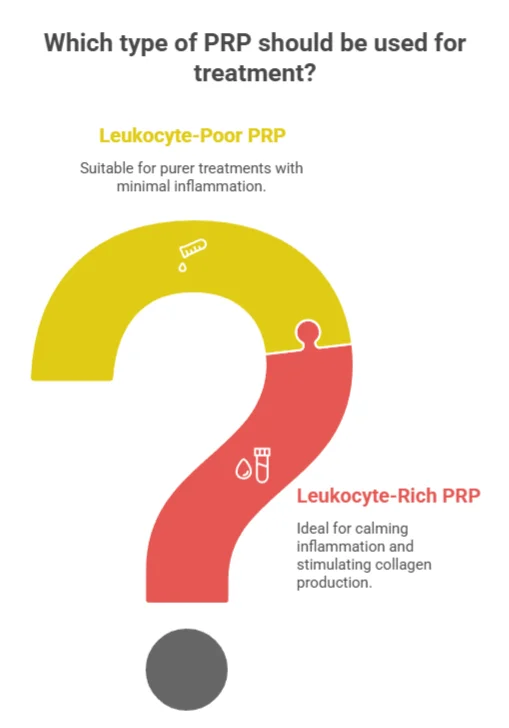
PRP isn't a passing trend - it’s a clinically supported approach rooted in your biology. Whether exploring skin rejuvenation, looking for an alternative to synthetic fillers, or seeking a proactive way to treat hair loss, understanding how PRP works is the first step.
The PRP Process Step By Step
Knowing what to expect can make all the difference if you're considering platelet-rich plasma (PRP) therapy. This treatment might be based on your biology, but the preparation process is carefully controlled, clinical, and highly precise.
From Blood Draw to Regeneration: Understanding the PRP Journey
Here's how PRP therapy unfolds in a clinical setting - from start to finish.
Step 1: Drawing Your Blood
- The process begins with a standard blood draw, usually from the arm.
- Around 10 to 30 millilitres is taken, similar to a routine blood test.
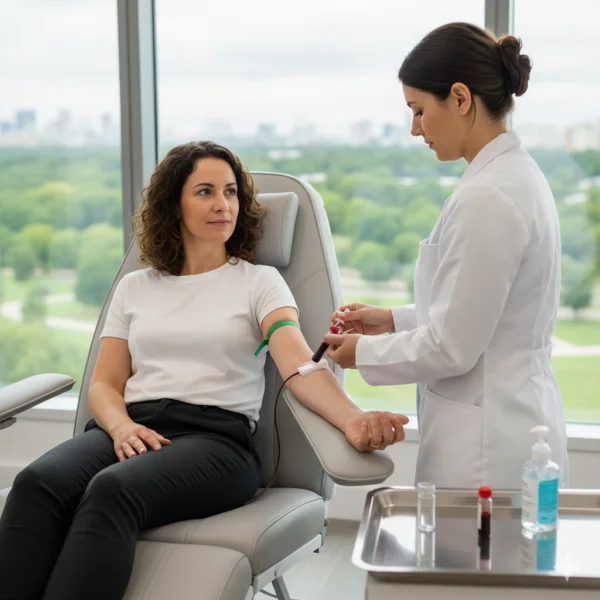
Step 2: Centrifugation
- The blood is placed into a centrifuge that spins rapidly to separate its components.
- This process isolates the platelet-rich plasma from red blood cells and platelet-poor plasma.
Step 3: Extracting the PRP
- The clinician carefully removes the middle layer, containing the concentrated platelets and plasma.
- This PRP solution contains a high density of growth factors essential for healing and rejuvenation.
Step 4: Optional Activation
- In some protocols, a substance like calcium chloride is added to "activate" the platelets.
- Activation encourages the immediate release of growth factors once the PRP is injected.
Step 5: Reinjecting the PRP
- Depending on the purpose, the PRP is then reinjected into the target area—skin, scalp, joints.
- Techniques vary: microneedling for facial treatments and deeper joint or hair therapy injections.
- A numbing cream may be applied beforehand to reduce discomfort.
Step 6: Recovery and Response
- There's minimal downtime - some redness or swelling is common for a day or two.
- PRP's regenerative effects begin gradually, stimulating collagen production and tissue renewal over time.
The Royal National Orthopaedic Hospital outlines protocols ensuring patient safety during PRP preparations, emphasising sterile techniques and specific patient medication restrictions (e.g., avoiding anticoagulants and NSAIDs prior to treatment). The MHRA mandates rigorous manufacturing and usage standards for PRP to maintain treatment safety and efficacy.
PRP therapy may look simple on the surface, but the science and technique behind it are anything but. It's a careful orchestration of biology, technology, and clinical expertise - all designed to help your body heal and revitalise itself, naturally.
How Does PRP Work Once Injected?
Once platelet-rich plasma (PRP) is injected into the target area - whether that’s your skin, scalp, or joints - the real work begins beneath the surface. PRP isn’t just a topical treatment; it’s a biological stimulus that sets off a powerful regenerative response within your own tissue.
Growth Factors: Nature’s Repair Signals
At the heart of PRP’s effectiveness are growth factors - natural proteins stored inside your platelets.
- Platelets release growth factors on contact
Once injected, your platelets become activated and begin releasing a potent mix of growth factors into the surrounding tissue. - Each growth factor plays a specific role
These include platelet-derived growth factor (PDGF) to attract repair cells, transforming growth factor beta (TGF-β) to stimulate collagen production, and vascular endothelial growth factor (VEGF) to improve blood supply. - The result? Enhanced cell signalling and tissue regeneration
These growth factors act like messengers, recruiting stem cells, fibroblasts and other repair agents to the site of injection.
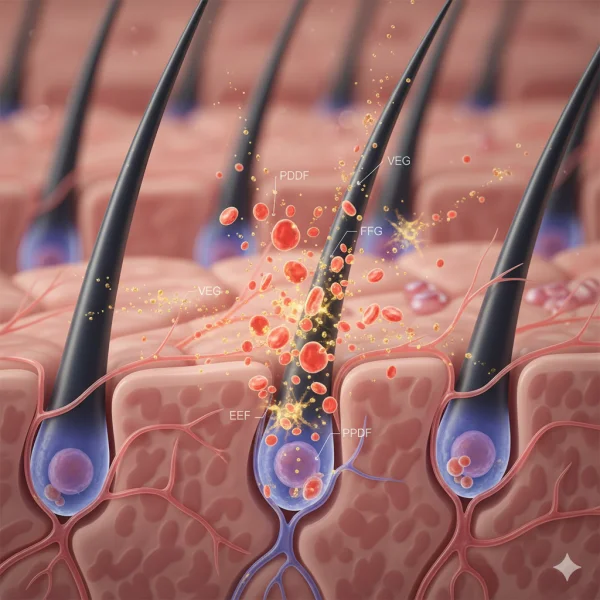
Stimulating Repair at a Cellular Level
PRP doesn’t mask problems - it addresses them at the root by encouraging biological renewal.
- Fibroblast activation for collagen synthesis
PRP stimulates fibroblasts, the cells responsible for creating collagen and elastin, which are essential for skin firmness and elasticity. - Increased blood flow for better nutrient delivery
VEGF promotes the formation of new capillaries, improving oxygenation and nutrient supply to the tissue. - Skin texture and tone improve over time
As collagen remodelling takes place, fine lines soften, pores reduce in size, and the skin takes on a more even, radiant appearance. - For hair loss, PRP supports follicle health
Injected into the scalp, PRP prolongs the growth (anagen) phase of the hair cycle, stimulates dormant follicles, and boosts overall scalp circulation. - In joints, PRP reduces inflammation and promotes cartilage repair
This can lead to a reduction in pain and improved mobility for individuals with osteoarthritis or tendon injuries.
PRP’s brilliance lies in its simplicity - it uses your own biology to amplify your body’s natural healing capacity. Whether applied for skin rejuvenation, hair regrowth or joint support, its regenerative potential is rooted in decades of medical research and clinical application.
What Affects PRP Effectiveness?
While platelet-rich plasma (PRP) therapy is grounded in your body’s natural healing potential, not every treatment delivers identical results. A range of factors - from your biology to your practitioner’s technique - can influence how well PRP works for you.
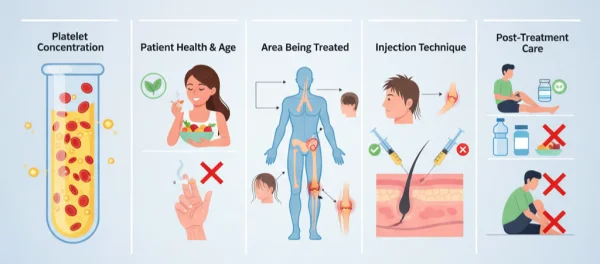
Personal Health, Practitioner Skill, and Protocol All Play a Role
To get the most from your PRP treatment, it helps to understand what’s happening behind the scenes - and what might influence outcomes.
Your Individual Biology
- Age matters
Younger individuals tend to have more responsive fibroblasts and higher levels of regenerative growth factors. However, this doesn’t mean PRP won’t work in later decades - it just may take more sessions for visible results. - General health and lifestyle
Factors like hydration, diet, sleep quality, and stress levels can all influence your body’s regenerative response. Smokers or heavy drinkers may see slower or less pronounced improvements. - Medications and underlying conditions
Regular use of anti-inflammatories (like ibuprofen) can dampen the healing response. Blood disorders, autoimmune conditions, or poorly controlled diabetes may also affect efficacy.
NHS protocols recommend comprehensive patient assessments to tailor treatment and manage expectations.
The PRP Itself
- Platelet concentration is key
Not all PRP is created equal. The concentration of platelets and quality of plasma can vary depending on how it’s prepared - too low, and it may be less effective. PRP concentrates platelets in a way that can be 5–10× baseline platelet counts, releasing growth factors that stimulate fibroblasts, collagen, angiogenesis, etc (source) . - Leukocyte-rich vs leukocyte-poor PRP
Different formulations are better suited to different uses. For example, leukocyte-poor PRP (P-PRP) is typically favoured for skin treatments, while leukocyte-rich PRP may be used in musculoskeletal applications. - Use of activators
Some protocols involve adding calcium chloride to trigger platelet activation before injection, enhancing the immediate release of growth factors.
Practitioner Technique and Technology
- Centrifuge precision and preparation protocol
The speed and timing of the centrifugation process directly affect the PRP’s purity and potency. - Injection technique and treatment area
Precise placement - whether into the dermis, scalp, or joint space - is critical. Expertise here influences how effectively growth factors reach their target. - Treatment frequency and aftercare
Most patients need a series of sessions for optimal results. Following post-treatment guidance - avoiding NSAIDs, using moisturisers, and protecting your skin from sun exposure - can significantly enhance outcomes.
Even though PRP is a natural, low-risk treatment, its effectiveness depends on more than just the procedure itself. The right candidate, the right formulation, and the right approach all contribute to better, longer-lasting results.
Realistic Expectations And Treatment Timeline
PRP therapy is a powerful regenerative treatment, but it’s not an overnight transformation. Understanding what to expect - and when - is essential for feeling confident and prepared throughout your journey.
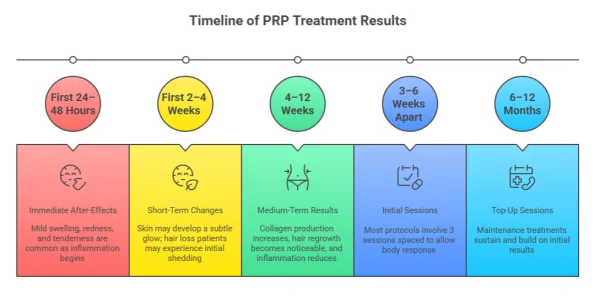
Results Build Over Time, Not Overnight
Because PRP works by stimulating your body’s natural healing processes, results are gradual and cumulative rather than instant.
Immediate After-Effects (First 24–48 Hours)
- Mild swelling and redness are common
These are signs of the body’s inflammatory response kicking in - usually settling within a couple of days. - Some tenderness or tightness may occur
Particularly if PRP is used on the face or scalp, you may feel a sensation similar to mild sunburn or post-exercise soreness.
Short-Term Changes (First 2–4 Weeks)
- A subtle “glow” may develop in the skin
Many patients notice their complexion looks fresher, dewier, or more hydrated within the first two weeks. - In hair loss treatment, initial shedding may occur
This is temporary and part of the follicle renewal process before growth begins.
Medium-Term Results (4–12 Weeks)
- Collagen production starts to increase
This leads to visible improvements in skin texture, firmness, and fine lines over the next few months. - Hair regrowth becomes more noticeable
Patients typically see reduced shedding and new baby hairs appearing from weeks 6 to 12. - For joints or scars, reduced inflammation and better mobility
The full anti-inflammatory effect and tissue repair benefit often emerges gradually across 2–3 months.
Long-Term Maintenance
- Most protocols involve 3 initial sessions
These are spaced 3–6 weeks apart to allow the body time to respond between treatments. - Top-up sessions every 6–12 months are recommended
These help sustain and build on the initial results, especially in ongoing skin or hair restoration plans.
PRP isn’t a quick fix, but it is a lasting one - especially when supported by good skincare, nutrition, and expert aftercare. Think of it as an investment in long-term vitality, rather than a one-time aesthetic boost.
Conclusion
PRP therapy isn’t about chasing perfection - it’s about supporting your body’s natural ability to repair, rejuvenate and thrive. Whether you’re exploring it for smoother skin, fuller hair, or joint relief, understanding how it works puts you in a stronger position to make a confident, informed decision.
At its core, PRP is a personalised approach to aesthetic and regenerative care. It doesn't rely on artificial enhancements but instead encourages subtle, lasting improvements that align with your body’s own rhythm. Results take time, but they’re rooted in real biological change - not quick fixes.
If you're considering PRP, speaking with a medically trained practitioner is the best next step. A tailored consultation will help you understand whether it’s right for your goals, your skin, and your timeline. Because the best results don’t just come from treatment - they come from being heard, understood, and supported every step of the way.
The Royal College of Podiatry (RCPod) and Chartered Society of Physiotherapy (CSP) caution that only properly licensed clinics and skilled practitioners should administer PRP, underscoring the importance of regulatory compliance for patient safety.
Your PRP Questions
Real Questions from Real People — Answered
Straightforward answers to the questions people like you are asking right now about PRP.

Cost of PRP treatment for hair?
Please give the cost and how many sessions needed to prevent complete hair loss and new hair
Hair loss.
Dear reader My name is Mo I'm interested to have prp treatment in your clinic and I have some questions How many ml of prp i will get injured ? Did you analyse prp There any other services after the treatment is done Thank you
To view all the PRP questions, please click here.
Or click here to ask your own question.
Find A Verified Clinic
Trusted PRP Experts, Local to You
Easily connect with qualified, verified professionals for safe, reliable treatment.


Hoole Medispa
51 Hoole Road, Hoole, Chester, CH2 3NH
Welcome to Hoole Spa and Aesthetics situated in the beautiful Grade II listed building in the suburbs of Hoole, Chester.
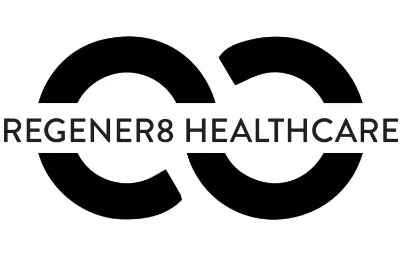
Regener8 Healthcare
42 Hewell Road, Barnt Green, Birmingham, B45 8NF
Regener8 Healthcare brings together a team of highly qualified specialists, who are all passionate about aesthetics, longevity and wellness treatments.
To find a PRP clinic near you, please click here.

